571 Welsh Terrier Breeds
THE TERRIERS OF WALES
by David Hancock
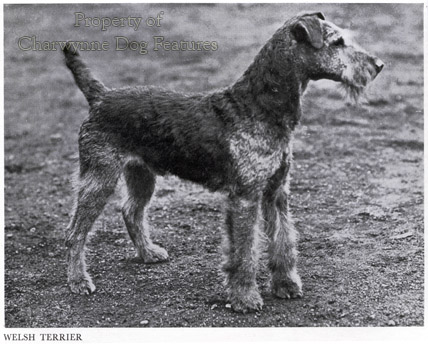 The show ring has claimed the two Welsh terrier breeds, with the Welsh Terrier by name holding its place and the Sealyham under threat of extinction in the coming decades. Yet there are devotees still working their own brand of Sealyham, keeping the pioneer breeders' work alive; there are 'Welsh Wheatens' in the working field too. The demise of the admirable Sealyham Terrier has been sad to witness over the years. With Kennel Club registrations going from 601 in 1914 to 2617 in 1925, and from 936 in 1960 to a mere 43 in 2008, this breed has had its share of fickle fanciers. Eighty years ago, Pierce O'Conor, in his Sporting Terriers, was writing: 'It is to be regretted, however, that in the past judges have too often awarded the highest honours at shows to large, heavy, clumsy-looking animals to the great deteriment of the breed...The real working type should not be extravagantly short of leg, and is comparatively light in bone with rather a long body.'
The show ring has claimed the two Welsh terrier breeds, with the Welsh Terrier by name holding its place and the Sealyham under threat of extinction in the coming decades. Yet there are devotees still working their own brand of Sealyham, keeping the pioneer breeders' work alive; there are 'Welsh Wheatens' in the working field too. The demise of the admirable Sealyham Terrier has been sad to witness over the years. With Kennel Club registrations going from 601 in 1914 to 2617 in 1925, and from 936 in 1960 to a mere 43 in 2008, this breed has had its share of fickle fanciers. Eighty years ago, Pierce O'Conor, in his Sporting Terriers, was writing: 'It is to be regretted, however, that in the past judges have too often awarded the highest honours at shows to large, heavy, clumsy-looking animals to the great deteriment of the breed...The real working type should not be extravagantly short of leg, and is comparatively light in bone with rather a long body.'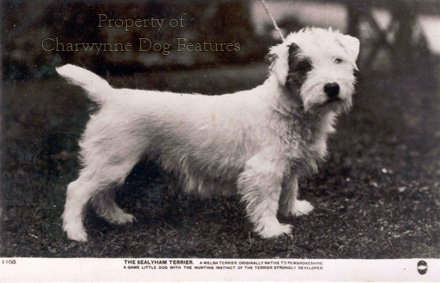
In his book The Sporting Terrier of 1992, Brian Plummer wrote: 'Sadly, one of the breeds that has been most damaged by the whims of breeders seeking to produce animals solely for exhibition has been the Sealyham terrier.' The portrayals of this breed down the years indicate all too vividly the descent from spunky active lively earth-dog to chunky less active specimen quite unable to fulfil its foundling function. If the registrations are anything to go by, all the show breeders have achieved is the obliteration of their favourite breed. And the Kennel Club, the self-appointed guardian of breeds of dog, have watched this happen. Once function is not bred for then the writing is on the wall for sporting and working breeds. 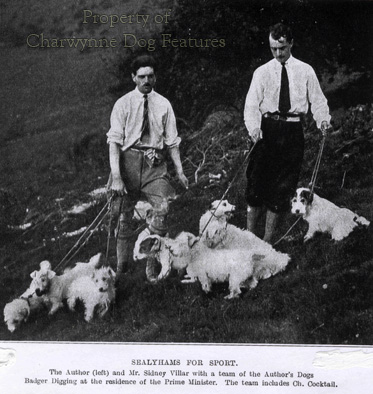
The famous terrier-breeder Sir Jocelyn Lucas hunted a pack of Sealyhams from his famous Ilmer kennel but it was his disillusionment with the show Sealyham which inspired his experiment with an outcross to the Norfolk terrier, then little known outside its native county. His working lines had been based on a dozen 'mini-Sealyhams' from the Master of the Pembrokeshire Foxhounds, subsequently blended with the renowned Gladdish Hulke's stoat-hunting working terrier pack, which Sir Jocelyn bought. Seeking a smaller working Sealyham, he outcrossed in the early 1950s to a red Norfolk terrier (which he referred to as a Norwich or Trumpington terrier), and was so pleased with the litter that he attempted to stabilise the type. He later described this type as 'death on rats and rabbits'.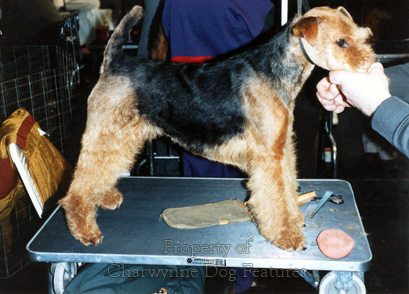
Finding the show Sealyham too big, too cloddy, over-furnished, with disappointing temperament and whelping difficulties, Lucas sought a smaller-headed, harsh-coated, coloured terrier which possessed both the physique and the character for hunting. He did not care for the excessive coat and box heads of the increasingly popular post second World War show Sealyham. His 'new breed' had handsome red jackets and a perky assertiveness which he admired. His first cross Sealyham-Norfolks were mainly coloured, ranging from red-tan to wheaten and even black and tan. But the second cross produced a proportion of mainly white or white-bodied progeny. We have the Sporting Lucas Terrier with us to this day. Sir Jocelyn's descendant, Lord Lucas, is president of the breed club.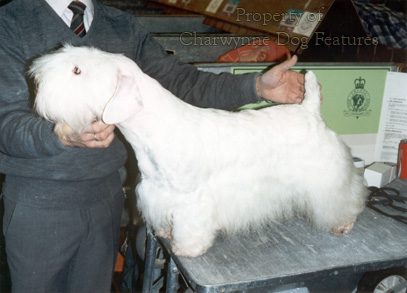
The other recognised Cambrian terrier and Welsh by name, has long had a loyal show following, with around 250 registered in 1908, 1960 and 2000, rising to 360 in 2008. This appealing breed exemplifies the old rough-coated black and tan terrier once found all over Britain; England could well have claimed the type as hers too. Bigger than a Lakeland and smaller than an Airedale, the Welsh Terrier makes up in character what it lacks in physical indentity. Once accused of being a wire-haired Fox Terrier in a different jacket, there have been too accusations of infusion of the latter's blood in this Welsh dog's development. The silhouette is markedly similar. It was argued that the old Welsh Terrier had a Chippendale front, poor shoulders, a big coarse apple head and big round bold eyes. The infusion of Fox Terrier blood allegedly produced a smarter-looking terrier but also introduced the long muzzled head.
At the Bangor Show of 1885, a group of Welsh terrier fanciers decided to approach the Kennel Club with a view to having their dogs registered as such. But the north of England breeders of similar dogs wished their rights to be acknowledged too. So, in November 1885, to satisfy both parties the KC agreed to enter in the Stud Book the classification 'Welsh Terrier or the Old English wire-haired Black and Tan Terrier Class 53'. Later, the fanciers of the English dogs failed to form a club and in time any reference to English terriers was deleted in registration and show documents. The subsequent recognition of the smaller Lakeland Terrier undoubtedly drew devotees of the English black and tan terriers with the Lakeland earning KC recognition in 1921. But 'Working Welsh' terriers of a separate type were still favoured.
Until sixty years ago, two kennels still bred Welsh black and tan working terriers: the Ynysfor Otterhounds and the Glasnevin Foxhound pack. The former were kept free of KC-registered Welsh Terrier blood, being smaller, 14lb, 13", box-headed dogs, much more like Fell Terriers. Inter-breeding has probably contributed to the muted tan of the Lakeland being replaced all too often by the fiery red-tan of the Welsh dogs. The Welsh Terrier has been described as the terrier giving the maximum of pleasure with a minimum amount of trouble, but some terriermen feel that they lack tenacity and committed prey-drive. Show critiques of recent years make disappointing reading, ranging from '...the quality of the breed has sadly deteriorated...' to '...this breed is deteriorating in both quality and movement...' This is an attractive breed with a sound working provenance from its distant past, one deserving attention.
It would be an enormous pity if both these Welsh terrier breeds, the Sealyham and the national dog, slowly disappeared not just from public view but from the working role too. It needs a few patriotic Welshmen to rally to the cause and perpetuate the selfless work done by the pioneers in each breed. We lost the Welsh Setter; let's keep the Welsh Terriers!